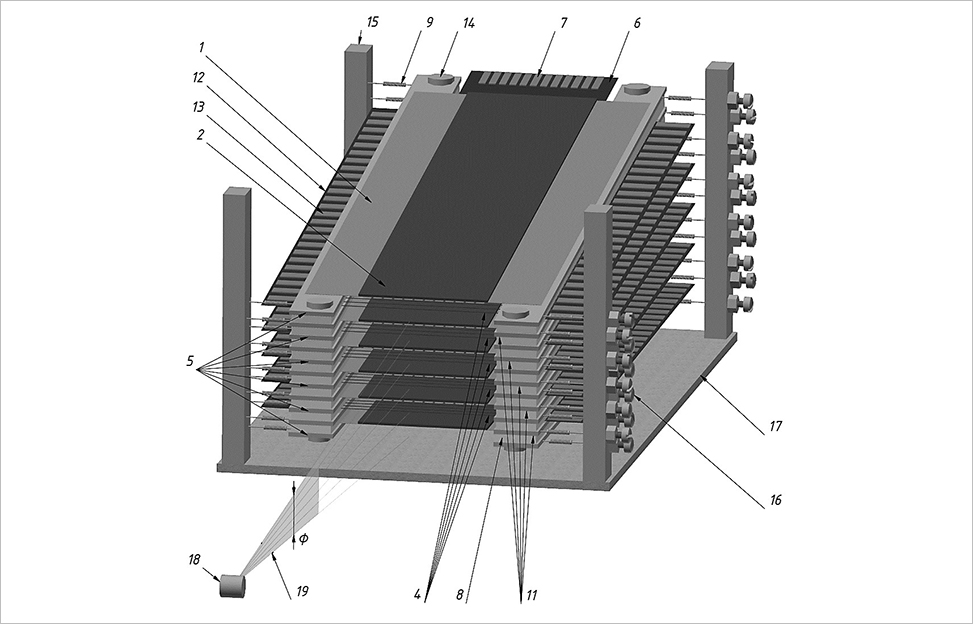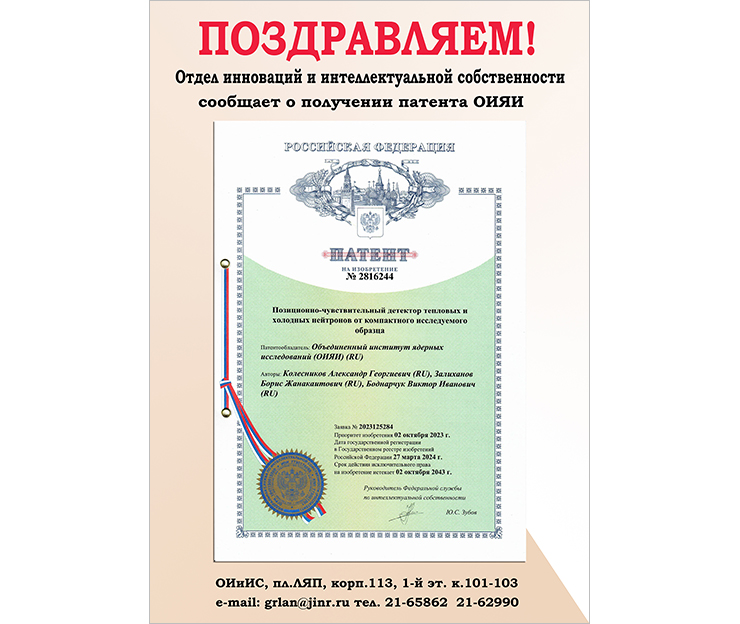FLNP and DLNP multi-foil neutron detector for work with closely spaced samples
Media, 24 June 2024
Researchers of the Laboratory of Neutron Physics and the Laboratory of Nuclear Problems at JINR continue to work on the design of a boron carbide based position-sensitive gas detector of thermal and cold neutrons, in which high neutron detection efficiency is achieved by small grazing angle of the neutron incidence on the solid converter surface. The previous version concerned cases when the test sample is at a great distance , more than 10 meters from the detector. The new invention will be used to detect neutrons scattered at close distance from the sample, from 1 meter.
Depending on the task, one or another patent will be used. “We are expanding the range of detectors that will have high registration efficiency, speed response, and the ability to operate in large neutron fluxes,” Alexander Kolesnikov, co-inventor of the detector, FLNP JINR leading engineer, noted. He explained that the detector is for the future, it will be relevant for new generation neutron sources such as PIK (Gatchina, Russia), European Spallation Source ESS (Lund, Sweden), NEPTUNE (Dubna, Russia), which will require detectors with high loading capacity. The ESS multi-blade detector served as a prototype for the invention. “We named our detector multi-foil. According to theoretical calculations, it has slightly increased efficiency and superior temporal resolution,” Alexander Kolesnikov commented.
 Neutron detector (body not shown): 1 — substrate; 2 — cathode; 4 — anode wires; 5 — substrate holder; 6 — strip lamella panel; 7 — strip lamellas; 8 — remote insert; 9 — spring elements; 11 — anode holder; 12 — anode plane; 13 — anode lamellas; 14 — tie (fasteners); 15 — strut (fasteners); 16 — tensioner of spring elements; 17 — detector base; 18 — compact test sample (or sample); 19 — neutron flux emitted by the sample 18; ϕ — divergence angle of the neutron flux incident into the detector from the sample 18
Neutron detector (body not shown): 1 — substrate; 2 — cathode; 4 — anode wires; 5 — substrate holder; 6 — strip lamella panel; 7 — strip lamellas; 8 — remote insert; 9 — spring elements; 11 — anode holder; 12 — anode plane; 13 — anode lamellas; 14 — tie (fasteners); 15 — strut (fasteners); 16 — tensioner of spring elements; 17 — detector base; 18 — compact test sample (or sample); 19 — neutron flux emitted by the sample 18; ϕ — divergence angle of the neutron flux incident into the detector from the sample 18
At this time, helium-3 based neutron detectors are the most widespread in nuclear physics. This gas detects charged particles produced during interaction of neutrons with helium-3 nuclei. However, helium-3 is limited in speed response. In addition, in order to increase the efficiency of the helium-based detector, the gas is pumped into the detector under high pressure, so that the walls of the chamber must be thick enough to withstand it. Some neutrons cannot get through the walls as they get scattered, especially ones with a long wavelength. According to Alexander Kolesnikov, in the range of long neutron wavelength, the boron carbide detector is more efficient than helium detectors, and in the range of 1.8 angstrom waves, it is slightly inferior: 64% of the efficiency of boron carbide detectors versus 70-80% for helium ones. In the new device, the detector chamber will be filled with a working gas at atmospheric pressure, and its walls will be thin, made of foil, so the loss of neutrons on the walls will be insignificant. “There are two important aspects for research centres now: conducting research in the long-wavelength range and in large fluxes, where high-speed measurements are needed. Boron carbide detectors are superior to the helium ones here,” Alexander Kolesnikov highlighted.
If neutrons fall to the material at right angles, then charged particles – reaction products after neutron capture by boron-10 nuclei – “get stuck” in the boron carbide layer, and the neutron detection efficiency does not exceed 5-6%. The inventors of the detector use inclined geometry to increase efficiency: neutrons will fall on thin plates coated with boron carbide at a small grazing angle (1-5°). Here, theoretical calculations show the possibility of achieving up to 64% detection of neutrons with a wavelength of 1.8 Å. At the same time, in the longer-wavelength part of the spectrum, the neutron detection efficiency will reach 90%. “High detection efficiency is achieved through the significant lengthening of neutron path in converter due to the small angle of the neutron incidence on its surface. Such detection geometry provides not only the increase in number of neutrons’ interactions with boron atoms, but also the rise of number of reactions which produce particles (lithium ion and alpha particle) able to move out of converter to the area of detection. High loading capacity of the multi-foil detector is provided accordingly to detection characteristics of the gas chamber, on which detector is based. The chamber was developed by DLNP JINR researcher Boris Zalikhanov,” Alexander Kolesnikov concluded.
Currently, FLNP JINR scientists are working on the design of the first detector sample, the production of which is planned in the future at the experimental site for the development and production of thermal neutron detectors being built at the FLNP.
 The VATT-800 Facility is the core of an experimental site for the development and production of thermal neutron detectors based on a boron carbide converter
The VATT-800 Facility is the core of an experimental site for the development and production of thermal neutron detectors based on a boron carbide converter
On 27 March 2024, the Joint Institute for Nuclear Research received patent RU 2816244 for a position-sensitive detector of thermal and cold neutrons from a compact test sample. The inventors are Alexander Kolesnikov (FLNP JINR), Boris Zalikhanov (DLNP JINR), Victor Bodnarchuk (FLNP JINR).
